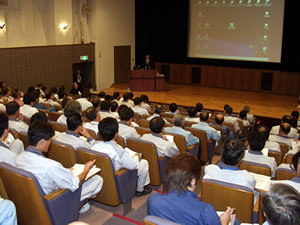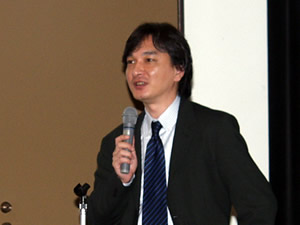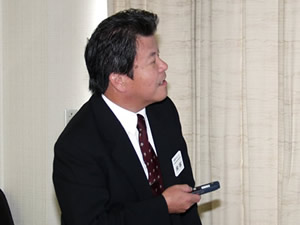|
|
 |
| The 86th Safety Caravan was conducted at the Nuclear Fuel Cycle Engineering Laboratories of Independent Administrative Corporation Japan Atomic Energy Agency in Tokai-mura, Naka-gun, Ibaraki Prefecture on September 8th 2006. |
|
| Safety Presentation
|

|
|
During the safety presentation
|
One hundred thirty nine employees of Japan Atomic Energy Agency and affiliated companies attended the Safety Presentation.
The presentation began with greetings from Mr. Hirofumi Oshima Director of the Nuclear Fuel Cycle Engineering Laboratories of the Japan Atomic Energy Agency. "Today we are honored by the presence of personnel from JANTI as well as Professor Okada of Keio University who will be speaking on how to make further advances in safety. Especially in regard to our nuclear energy research, I believe that although a small improvement can be seen including matters of budget, it is only when management of the worksite on a daily basis has been accomplished that we can say that our research work is proceeding efficiently. Especially, in daily operations at the worksite, I believe that it is extremely important to handle nuclear fuel materials and radioactive materials with absolute safety. Based on that perspective, Professor Okada from Keio University will deliver a speech on the theme of 'the development of human error management'. Instead of looking at errors from the perspective of individual persons causing them, I believe it is of the utmost importance to make suitable improvements and take preventive measures against recurrence, including hardware, after making proper assessment. Through this lecture, we, too, shall aim to acquire and develop wisdom that we can apply in the performance of our day to day work duties."
After this salutation, JANTI introduced the current state of activities, followed by the lecture "the Development of Human Error Management" by Assistant Professor Yusaku Okada, School of Science for Open and Environmental Systems, Graduate School of Science and Technology , Department of Administration Engineering, Faculty of Science and Technology, Keio University . |
Lecture highlights |

|
|
Mr.Yusaku Okada
|
In the course of the lecture, some very valuable points were brought out such as the following.
The establishment of HEMS, or Human Error Management System, which is a mechanism for preventing human errors that can be the source of trouble in safety management and quality control, is one of the serious issues facing present day business enterprises and organizations. The role borne by that system is not only to analyze troubles of the past in fine detail to prevent the same trouble from recurring (recurrence prevention), but it must also expand into the realm of suppressing the possibility of trouble occurring in the future (proactive prevention).
In regard to the prevention of recurrence, we must analyze and evaluate the mechanism of occurrence of human errors leading to trouble, in other words, to accurately extract the PSF, or Performance Shaping Factors, that are the source of the human error. And in doing so, giving consideration to PSF in greater detail and from a wide perspective will lead to effective measures for the prevention of recurrence. Up until now a number of methods for drawing out PSF have been proposed, but in the case of every method, the experience and competence of the user, in other words the person who performs the analysis, greatly influences the outcome. As far as problem analysis is concerned, I recommend educating the analysts and evaluators of each organization so that they should not be of the mind set that simply knowing the technique is enough, but to also attend lectures by persons experienced in method analysis and experts on the human factor, and analyze the origins and the factors so as to attain substantial results.
On the other hand, as far as proactive prevention is concerned, we can broadly divide actions desirable by organizations into two types. One is the evaluation of the seeds of human error, and weeding out those seeds (an ounce of prevention is worth a pound of cure). The other is awareness of safety and organizational climate, or the so-called safety culture that is represented by the organizational climate. Needless to say, this applies not only to safety but is also sought in relation to quality control and service management, in other words, recognition of human error and the implementation of appropriate measures to prevent human error, and furthermore, the management of the structure of those items. |
In the questionnaire after the presentation, the following opinions were expressed.
•Instead of clinging to the perception of human error (H.E.) being a mistake (negligence) on the personal level, I whole-heartedly agree with the transition to the multi-faceted concept of the HEM framework that encompasses total management. H.E. always tends to be evaluated as a result phenomenon, reverting back to personal attributes. And because of that, there is no arrival at a conclusion of the actual root causes, the indirect factors and background factors including work procedures, working environment and organizational causes. And such being the case, troubles of the same breed and genre will recur. And so, a viscous circle is born where the source is cognitively evaluated more and more as the personal attributes of the repeater, and thus I keenly feel the importance of diverting, establishing and developing the orientation based on deviation as pointed out in the professor's lecture.
•I have attended a number of lectures on human error, but I was really able to relate to today's lecture about going to the extent of analyzing the factors and what needs to be done. There are workers who can not understand the manuals, and as far as passing down technical prowess to successive generations is concerned, I felt that perhaps it may be necessary to reconsider the way technology is being passed down.
• Along with the reliable implementation of countermeasures for preventing recurrence of troubles caused by human error, the lecturer's persuasive power lies in the insistence on the point of systematically carrying out analysis of the latent factors and proactive prevention within the organization (managing).
• In regard to human error, rather than place the responsibility on the person himself or herself, I reached the understanding that it is necessary to take measures that include the analysis of the gray background area (not plainly seen causes, but factors that have the possibility of becoming contributing factors to trouble). This lecture was extremely useful to me.
• I believe every department makes tactical responses, but perhaps from the strategic perspective, they might be insufficient. The thoughts of those at the worksite are very much toward resolving the issues as quickly as possible, and it is difficult to incorporate a future outlook into the measures. I felt that it would be a good thing to consider the creation of a full time position for a person who would formulate strategy for facilitating communication between the safety management department and the worksite.
|
Safety information exchange session |

|
|
Mr.Kazuo Murai
|
(1)
Introduction of endeavors and exchange of opinions
Mr. Kazuo Murai, Senior Chief Engineer, Office of Technology Development and Promotion of Nuclear Development Corporation attended the safety information exchange session and explained the details of activities for electronic technological support and passing down of technology (e-transmission activities) used at Nuclear Development Corporation.
Also, Mr. Keiichi Mizutani, Deputy Manager of the Safety Measures of the Security Management Department of the Nuclear Fuel Cycle Engineering Laboratories of Japan Atomic Energy Agency introduced endeavors for fostering safety culture "Endeavors in the Succession of Technology and Safety Activities at the Fuel Cycle Lab."
After the presentations, information and opinions were exchanged regarding the above-mentioned activities and endeavors. (2) Other
JANTI's NSnet Division explained about the Division's nuclear power safety culture fomenting database and information and the like.
|
|
|







